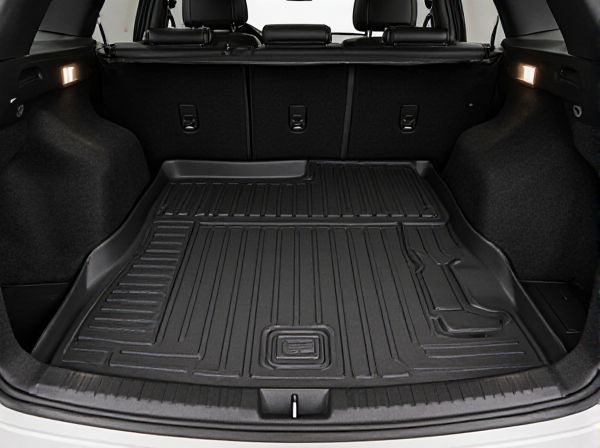
Photo illustration: Carpet Liner vs Rubber Mat
Carpet liners provide a soft, cushioned surface that protects your floor beneath while adding insulation and reducing noise. Rubber mats offer superior durability, water resistance, and slip prevention, making them ideal for high-traffic or wet areas. Choosing the right option depends on whether you prioritize comfort and warmth or heavy-duty protection and traction for your space.
Table of Comparison
| Feature | Carpet Liner | Rubber Mat |
|---|---|---|
| Material | Soft textile fibers | Durable rubber |
| Water Resistance | Low, absorbs moisture | High, waterproof surface |
| Durability | Moderate, prone to stains | High, resistant to wear and tear |
| Cleaning | Requires vacuuming and shampoo | Easy wipe or hose down |
| Comfort | Soft and cushioned | Firm and non-slip |
| Appearance | Elegant, textured look | Functional, utilitarian style |
| Price Range | Moderate | Affordable to moderate |
Introduction to Carpet Liners and Rubber Mats
Carpet liners are designed to provide cushioning and protection beneath floor carpets, enhancing comfort while preventing wear and tear. Rubber mats offer durable, slip-resistant surfaces ideal for high-traffic areas and environments prone to moisture or dirt. Both products serve distinct purposes in flooring solutions, with carpet liners prioritizing softness and rubber mats emphasizing resilience and safety.
Material Composition and Durability
Carpet liners are typically made from synthetic fibers like polyester or polypropylene, offering a soft surface that resists stains and mildew but may wear faster under heavy use. Rubber mats consist of natural or synthetic rubber compounds, providing superior durability, water resistance, and enhanced grip to prevent slipping. The rubber's robust material composition ensures longer-lasting performance in harsh conditions compared to the more delicate fiber-based carpet liners.
Comfort and Cushioning Comparison
Carpet liners offer superior comfort and cushioning due to their plush, fabric-based construction that absorbs shocks and reduces fatigue during long drives. Rubber mats provide durable protection but lack the soft, cushioned feel, often resulting in a firmer underfoot experience. Choosing carpet liners enhances interior comfort by combining cushioning with noise reduction, whereas rubber mats prioritize durability over softness.
Protection Against Spills and Stains
Carpet liners absorb liquid spills, reducing the risk of stains by trapping moisture beneath the surface, but they can retain odors if not cleaned promptly. Rubber mats provide a waterproof barrier that prevents spills from seeping into the vehicle's flooring, making them easier to clean and maintain over time. Both options protect against stains, but rubber mats offer superior spill containment and durability for messy environments.
Ease of Cleaning and Maintenance
Carpet liners absorb dirt and moisture, requiring frequent vacuuming and occasional shampooing to maintain cleanliness, which can be time-consuming. Rubber mats offer superior ease of cleaning due to their non-porous surface, allowing for quick rinsing and wiping without trapping debris. Maintenance costs are lower for rubber mats as they resist stains and odors better compared to carpet liners, enhancing long-term durability.
Installation Process and Fit
Carpet liners are typically custom-cut to match the vehicle's exact floor dimensions, ensuring a snug and precise fit that reduces movement during use. Rubber mats offer more versatility with universal sizing but may require trimming or additional securing methods to fit perfectly in specific vehicle models. The installation of carpet liners is generally straightforward, involving simple placement and securing mechanisms, while rubber mats can be quickly laid down or removed, making them convenient for users seeking ease and flexibility.
Cost-Effectiveness and Value
Carpet liners typically offer a lower upfront cost compared to rubber mats, making them a budget-friendly option for basic vehicle protection. Rubber mats provide enhanced durability and long-term value by resisting wear, stains, and moisture more effectively, reducing replacement frequency. Evaluating cost-effectiveness depends on usage intensity; rubber mats deliver superior protection and longevity, while carpet liners serve well in lighter, cost-conscious applications.
Style and Aesthetic Appeal
Carpet liners offer a plush, textured appearance that enhances interior elegance and complements various vehicle color schemes, while rubber mats provide a sleek, utilitarian look favored for rugged durability. Carpet liners often feature custom embroidery and diverse color options, boosting personalization and visual harmony with the car's interior. Rubber mats emphasize bold, industrial design elements, appealing to those seeking a minimalistic yet robust aesthetic.
Best Use Cases for Each Option
Carpet liners excel in providing cushioning and noise reduction, making them ideal for passenger vehicles where comfort is key. Rubber mats offer superior durability and water resistance, perfect for trucks, SUVs, and areas prone to mud, snow, or heavy spills. For those prioritizing easy cleaning and protection against harsh elements, rubber mats hold the advantage, while carpet liners suit everyday driving with moderate wear conditions.
Which Is Better: Carpet Liner or Rubber Mat?
Carpet liners provide a soft, cushioned surface ideal for interior protection and noise reduction, while rubber mats offer superior durability and ease of cleaning, especially in wet or heavy-use environments. For all-weather resistance and heavy-duty applications, rubber mats outperform carpet liners by preventing moisture retention and providing enhanced grip. Selecting between carpet liners and rubber mats depends on vehicle use, climate conditions, and desired maintenance, with rubber mats being better suited for rugged protection and carpet liners favored for comfort and aesthetic appeal.
 caratoz.com
caratoz.com